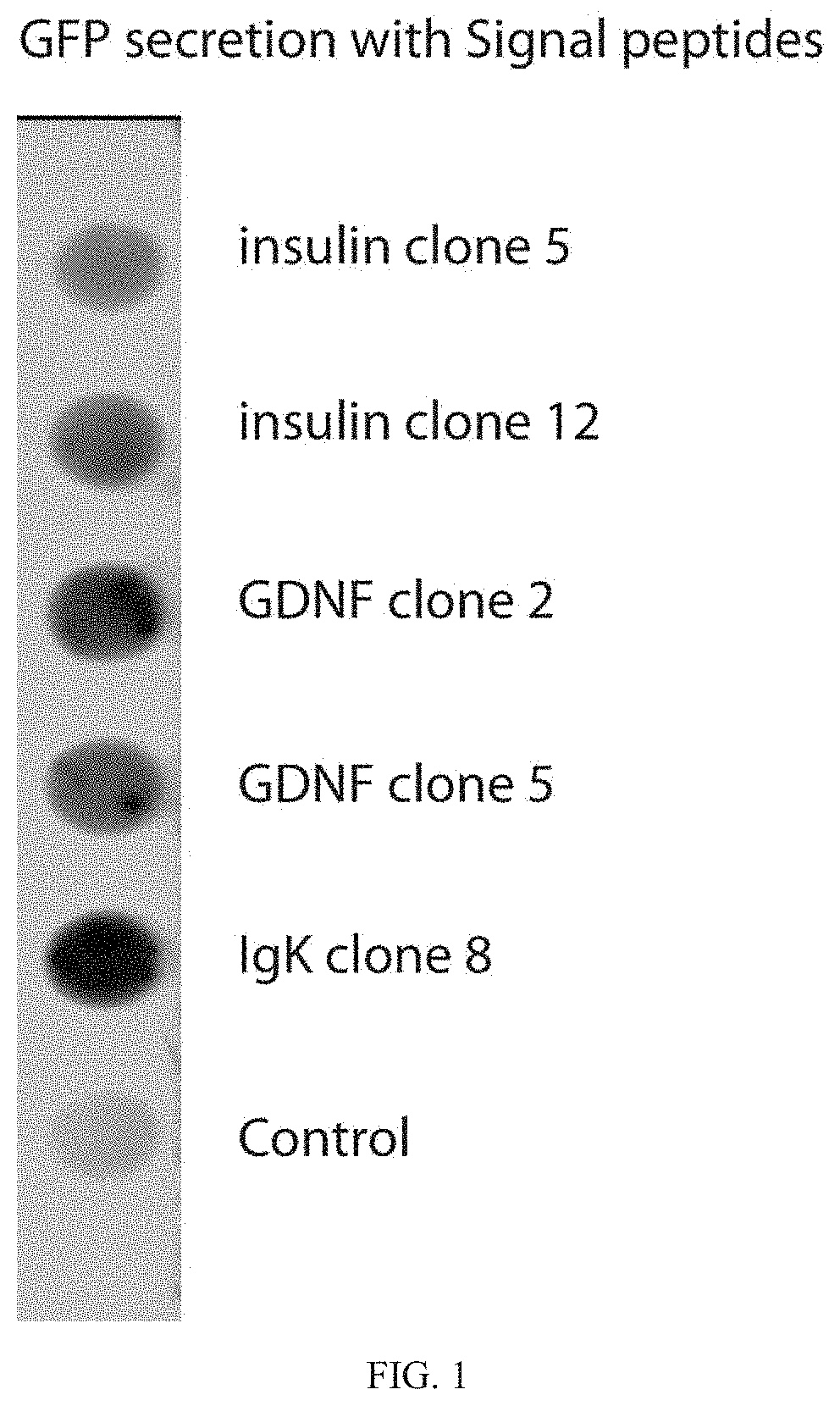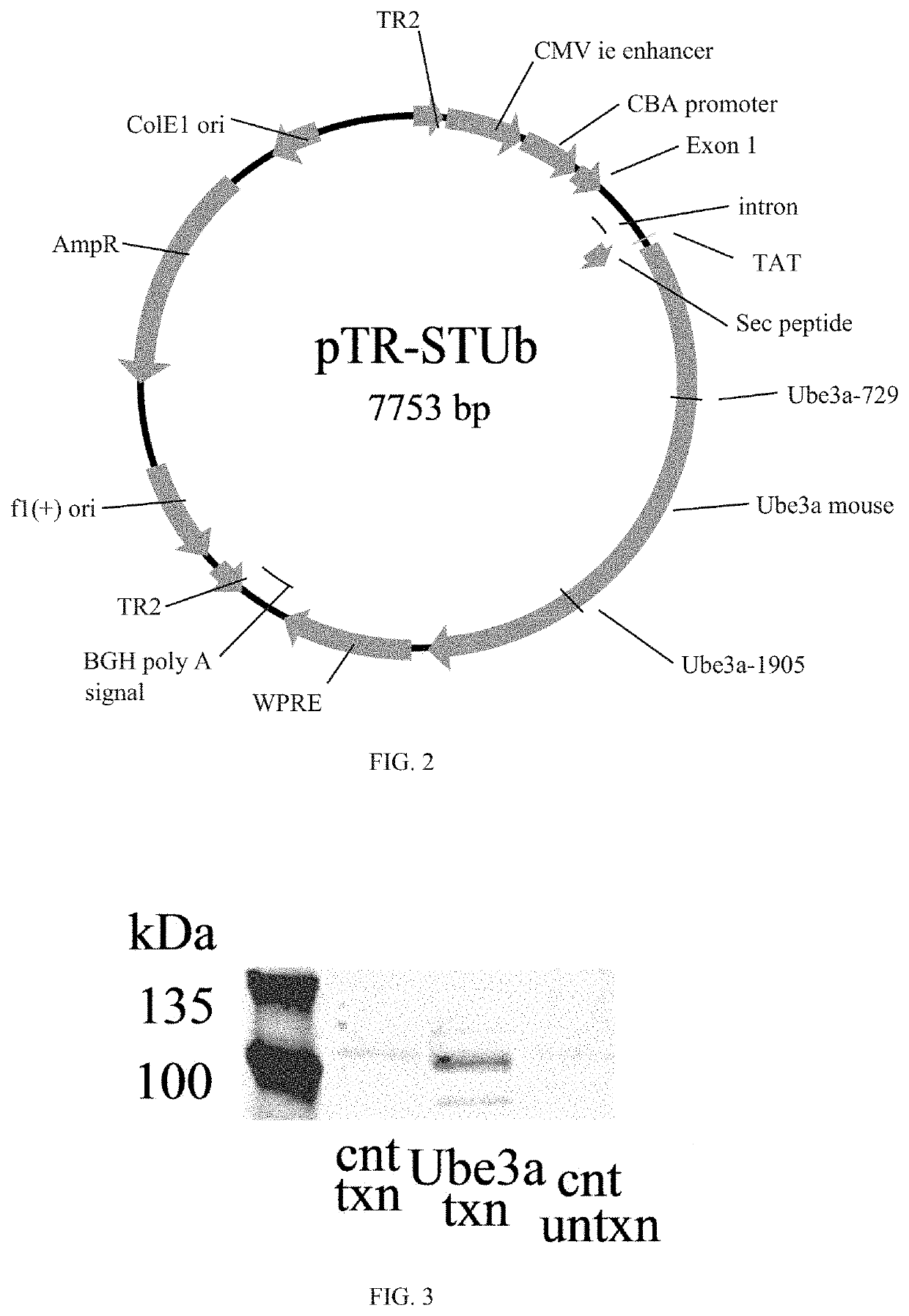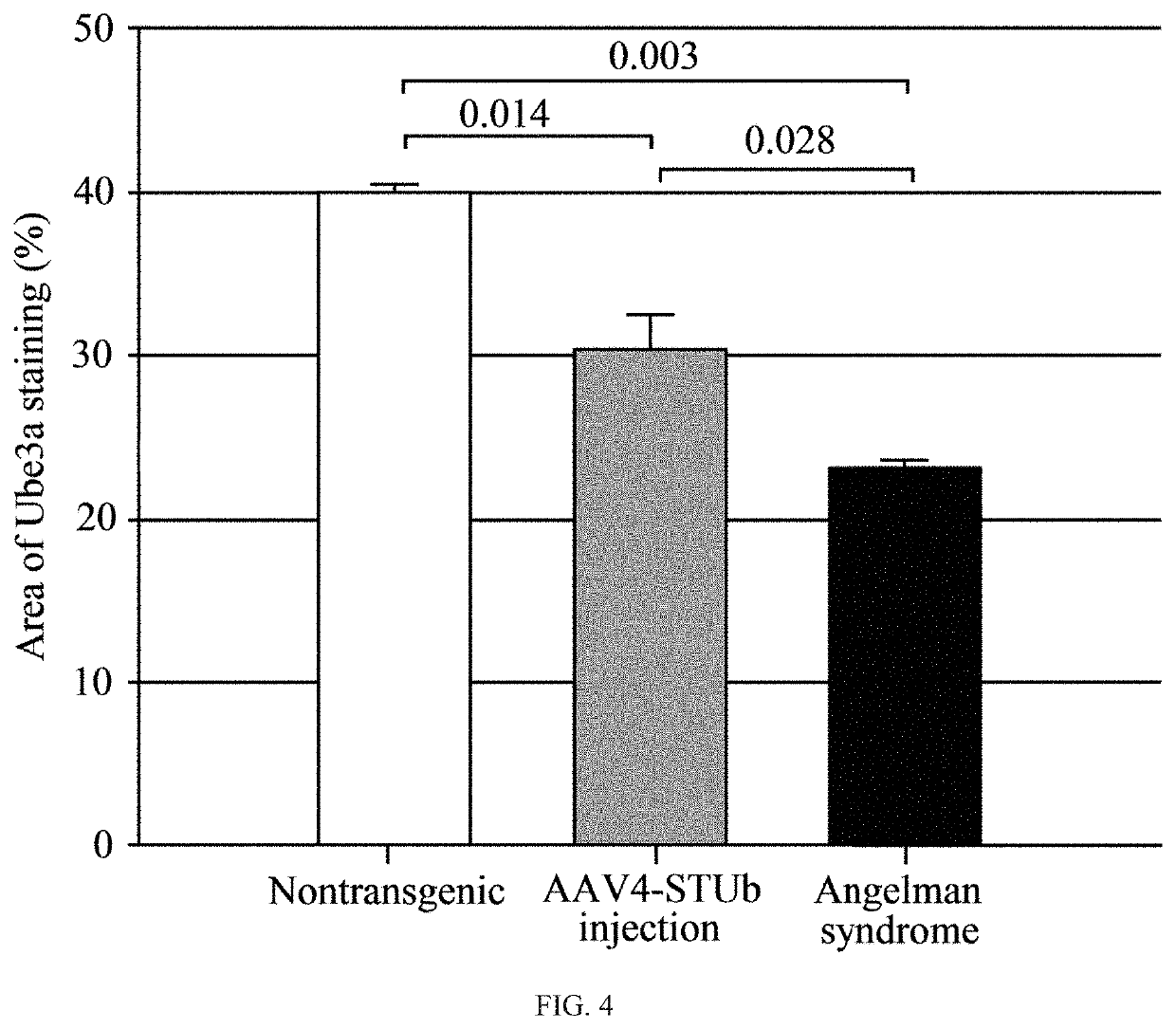Modified ube3a gene for a gene therapy approach for angelman syndrome
a gene therapy and gene therapy technology, applied in the field of treating angelman syndrome, can solve the problems of sensitivity to heat, sleep apnea, sucking and swallowing problems,
- Summary
- Abstract
- Description
- Claims
- Application Information
AI Technical Summary
Benefits of technology
Problems solved by technology
Method used
Image
Examples
example 1
[0088]To test the efficacy of the secretion signal, GFP (SEQ ID No: 1) (XM 013480425.1) was cloned in frame with human insulin, GDNF (SEQ ID No: 2) (AB675653.1) or IgK signal peptides.
(SEQ ID No: 1)ATGGCTCGTC TTTCTTTTGT TTCTCTTCTT TCTCTGTCACTGCTCTTCGG GCAGCAAGCA GTCAGAGCTC AGAATTACACCATGGTGAGC AAGGGCGAGG AGCTGTTCAC CGGGGTGGTGCCCATCCTGG TCGAGCTGGA CGGCGACGTA AACGGCCACAAGTTCAGCGT GTCCGGCGAG GGCGAGGGCG ATGCCACCTACGGCAAGGAC TGCCTGAAGT TCATCTGCAC CACCGGCAAGCTGCCCGTGC CCTGGCCCAC CCTCGTGACC ACCTTCGGCTACGGCCTGAT GTGCTTCGCC CGCTACCCCG ACCACATGAAGCAGCACGAC TTCTTCAAGT CCGCCATGCC CGAAGGCTACGTCCAGGAGC GCACCATCTT CTTCAAGGAC GACGGCAACTACAAGACCCG CGCCGAGGTG AAGTTCGAGG GCGACACCCTGGTGAACCGC ATCGAGCTGA AGGGCATCGA CTTCAAGGAGGACGGCAACA TCCTGGGGCA CAAGCTGGAG TACAACTACAACAGCCACAA CGTCTATATC ATGGCCGACA AGCAGAAGAACGGCATCAAG GTGAACTTCA AGATCCGCCA CAACATCGAGGACGGCAGCG TGCAGCTCGC CGACCACTAC CAGCAGAACACCCCCATCGG CGACGGCCCC GTGCTGCTGC CCGACAACCACTACCTGAGC TACCAGTCCG CCCTGAGCAA AGACCCCAAC...
example 2
3A Vector Construct
[0094]A mouse-UBE3A vector construct was generated using a pTR plasmid. The mouse (Mus musculus) UBE3A gene was formed from cDNA (U82122.1);
(SEQ ID No: 4)ATGAAGCGAG CAGCTGCAAA GCATCTAATA GAACGCTACTACCATCAGTT AACTGAGGGC TGTGGAAATG AGGCCTGCACGAATGAGTTT TGTGCTTCCT GTCCAACTTT TCTTCGTATGGATAACAATG CAGCAGCTAT TAAAGCCCTT GAGCTTTATAAAATTAATGC AAAACTCTGT GATCCTCATC CCTCCAAGAAAGGAGCAAGC TCAGCTTACC TTGAGAACTC AAAAGGTGCATCTAACAACT CAGAGATAAA AATGAACAAG AAGGAAGGAAAAGATTTTAA AGATGTGATT TACCTAACTG AAGAGAAAGTATATGAAATT TATGAATTTT GTAGAGAGAG TGAGGATTATTCCCCTTTAA TTCGTGTAAT TGGAAGAATA TTTTCTAGTGCTGAGGCACT GGTTCTGAGC TTTCGGAAAG TCAAACAGCACACAAAGGAG GAATTGAAAT CTCTTCAAGA AAAGGATGAAGACAAGGATG AAGATGAAAA GGAAAAAGCT GCATGTTCTGCTGCTGCTAT GGAAGAAGAC TCAGAAGCAT CTTCTTCAAGGATGGGTGAT AGTTCACAGG GAGACAACAA TGTACAAAAATTAGGTCCTG ATGATGTGAC TGTGGATATT GATGCTATTAGAAGGGTCTA CAGCAGTTTG CTCGCTAATG AAAAATTAGAAACTGCCTTC CTGAATGCAC TTGTATATCT GTCACCTAACGTGGAATGTG ATTTGACATA TCATAATGTG TATACTCGAGATCCTAA...
example 3
Testing of Mouse-UBE3A Vector Construct
[0099]The mouse vector properties of the construct generated in Example 2 were tested in HEK293 cells (American Type Culture Collection, Manassas, Va.). HEK293 cells were grown at 37° C. 5% CO2 in Dulbecco's Modified Essential Medium (DMEM) with 10% FBS and 1% Pen / Strep and subcultured at 80% confluence.
[0100]The vector (2 μg / well in a 6-well plate) was transfected into the cells using PEI transfection method. The cells were subcultured at 0.5×106 cells per well in a 6-well plate with DMEM medium two days before the transfection. Medium was replaced the night before transfection. Endotoxin-free dH2O was heated to at around 80° C., and polyethylenimine (Sigma-Aldrich Co. LLC, St. Louis, Mo.) dissolved. The solution was allowed to cool to around 25° C., and the solution neutralized using sodium hydroxide. AAV4-STUb vector or negative control (medium only) was added to serum-free DMEM at 2 μg to every 200 μl for each well transfected, and 9p of 1 ...
PUM
| Property | Measurement | Unit |
|---|---|---|
| time | aaaaa | aaaaa |
| neurodegenerative disorder | aaaaa | aaaaa |
| synaptic plasticity | aaaaa | aaaaa |
Abstract
Description
Claims
Application Information
 Login to View More
Login to View More - R&D
- Intellectual Property
- Life Sciences
- Materials
- Tech Scout
- Unparalleled Data Quality
- Higher Quality Content
- 60% Fewer Hallucinations
Browse by: Latest US Patents, China's latest patents, Technical Efficacy Thesaurus, Application Domain, Technology Topic, Popular Technical Reports.
© 2025 PatSnap. All rights reserved.Legal|Privacy policy|Modern Slavery Act Transparency Statement|Sitemap|About US| Contact US: help@patsnap.com



